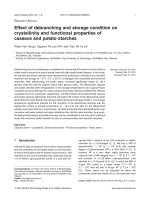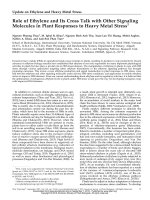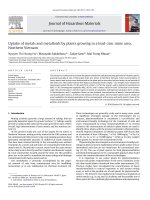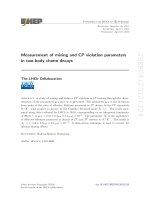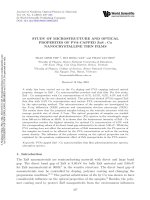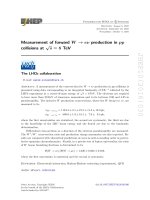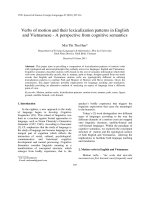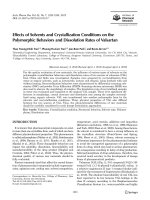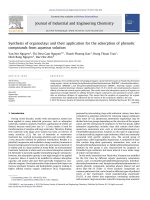DSpace at VNU: Verbs of motion and their lexicalization patterns in English and Vietnamese - A perspective from cognitive semantics
Bạn đang xem bản rút gọn của tài liệu. Xem và tải ngay bản đầy đủ của tài liệu tại đây (191.96 KB, 8 trang )
VNU Journal of Science, Foreign Languages 27 (2011) 107-114
Verbs of motion and their lexicalization patterns in English
and Vietnamese - A perspective from cognitive semantics
Mai Thi Thu Han*
Department of Foreign Languages & Informatics, Hoa Lu University,
Ninh Nhat District, Ninh Binh, Vietnam
Received 10 June 2011
Abstract. This paper aims at providing a comparison of lexicalization patterns of motion verbs
with typological and universal principles they embody across two languages: English and Vietnamese.
Cognitive semantics classifies motion verbs based on the sort of semantic information which their
verb roots characteristically encode, that is, manner, path or shape. Insights gained from our study
reveals that English and Vietnamese motion verbs are typologically different in utilizing
lexicalization patterns to conflate Path and Manner of Motion with Move elements. Given the
conclusions, this paper indicates possible implications for language teaching and translation,
hopefully providing an alternative method of analyzing an aspect of language from a different
point of view.
Keywords: Motion, motion verbs, lexicalization patterns, motion event, manner, path, cause, figure,
ground, satellite-framed, verb-framed.
1. Introduction*
speaker’s bodily experience that triggers the
linguistic expressions that carry the meaning(s)
to the hearer(s).
Talmy’s [2] work distinguishes two different
types of languages according to the way the
different elements of a motion event are mapped
onto linguistic elements: satellite-framed and
verb-framed languages. Within the paradigm of
cognitive semantics, we explored the conceptual
structure of motion and the typological surface
of both English and Vietnamese, inferring the
implications to facilitate both language teaching
and translation.
In the eighties, a new approach to the study
of language began to develop: Cognitive
Linguistics (CL). This school of linguistics was
born as a reaction against formal approaches to
language, such as Noam Chomsky’s Generative
Grammar (1957, 1965). According to Fauconier
[1], CL emphasizes that the study of language is
the study of language use because language is an
integral part of cognition which reflects the
interaction of social, cultural, psychological,
communicative and functional cognitive
development and mental processing. Cognitive
Semantics consider linguistic meaning as a
manifestation of conceptual structure, which
emerges from bodily experience, that is, the
2. Motion verbs in English and Vietnamese
______
*
Motion verbs - “the verbs that describe
movement are first learned, most frequently used
Tel: 84-982304678
E-mail:
107
M.T.T. Han / VNU Journal of Science, Foreign Languages 27 (2011) 107-114
108
and conceptually dominant” (Miller & JohnsonLaird [3]). The semantic function of a verb is to
describe a motion, an act, occurrence, or mode of
being. As analyzed in Mai Thu Han [4], both
English and Vietnamese motion verbs can be
transitive and intransitive, mostly in the patterns
of SV and SVO. Also, Vietnamese motion verbs
pattern with English equivalents in that many of
them are manner-of-motion verbs which couple
with another word to express the path of motion.
For example:
(1) I
ran
across the road.
Manner verb
path
Besides the common SV or SVO pattern,
Vietnamese motion verbs tend to encode a
complex motion event forming serial verb
constructions (SVCs). Beecher [5] identifies
three prominent variety of SVCs:
(i) Activity-Goal:
Tôi đến tìm em.
(seen as V + V)
(I came to look for you)
(ii) Resultative:
Gió thổi bay mái nhà.
(V + V)
(The wind blew off the roof of the house)
(iii) Motion-Path:
Tôi rơi vào một cái hố. (V + V)
(I fell into a hole)
These formations are hardly seen in English.
The typical formation of motion verbs in English
is Verb-particle/preposition constructions.
In addition, Vietnamese uses directional
complement verbs (DC verbs) to encode the Path
of Motion (Vmanner/cause + Directional
Complement verbs) as in (2) whereas in English,
the path of motion is incorporated in the particles
(Vmanner/cause + particles or prepositions) as in
(3). For example:
(2) Xe đã chạy
qua
cầu.
Motion + Manner
Direction
(Verb)
(Directional complement verb)
(3) The car
ran
across
the bridge.
Motion + Manner
Direction
(Verb)
(pre)
In English, the Latin-derived pathincorporating verbs such as ascend, descend,
enter, exit … are only directional full verbs. The
Vietnamese counterparts of these words are
categorized as both full verbs encoding the Path
of the motion, and ‘directional complement verbs’
which stand after motion verbs and convey
prepositional meanings. These path verbs carry
two semantic meanings and often require an
Olocative: Motion and Direction of Motion. E.g.:
(4) Tôi
rời
ga tiễn,
chui
vào
chiếc xe taxi...
V Olocative
V + Vdirection
Regarding motion verbs, we present here a list
of path verbs which may function as both full verbs
and directional complement verbs conveying the
meanings of prepositions in Vietnamese:
Table 1: Path verbs and directional complement verbs in Vietnamese
1
2
3
4
5
6
7
8
9
Path verbs/ Directional complement verbs
qua/sang
về/ lại
vào (trong)
ra (khỏi)
lên
xuống
lại/ tới
đến/tới
đi (khỏi)
ộnk
Full verbs (in English)
to cross/get (over), pass
to come/go back
to enter
to exit
to ascend
to descend
to arrive
to reach
to go
Preposition meaning
across
back
in(to)
out (of)
up
down
at
at
off/away
M.T.T. Han / VNU Journal of Science, Foreign Languages 27 (2011) 107-114
One more different thing lies in the semantic
description of manner. In English manner verbs,
manner category is encoded in the verbs
themselves. Not to run parallel with this,
Vietnamese tends to use more neutral motion
verbs plus an adjunct adding manner information
to the main motion verbs. For example, the
English verbs amble, backpack, meander, inch,
limp, mince … express different ways of walking,
and they are translated into Vietnamese as đi
thong thả, đi lang thang, đi lần lần, đi khập
khiễng, đi õng ẹo, … .
In summary, English and Vietnamese motion
verbs share the similarities and make the
differences in both the syntactic and semantic
features. Those are the things drawn out as the
basis for further comparison.
3. Tamy’s lexicalization patterns
Lexicalization is one of those terms which
linguists do not use in the same way. In volume
II of Toward a Cognitive Semantics (2000),
Leonard Talmy delves into the exploration of
the systematic relations in language between
meaning and overt linguistic forms, in other
words, into the process of lexicalization (Talmy
[6]):
Lexicalization is involved where a particular
meaning component is found to be in regular
association with a particular morpheme.
In my understanding, new concepts that are
given lexical form become part of the lexicon of
a language and the process of establishing a new
unit in any specific lexicon is commonly referred
to as lexicalization. In other words, lexicalization
is the process by which concepts are encoded in
words.
Talmy’s basic assumption is that we can
isolate elements or components separately within
the domain of meaning and within the domain of
linguistic expression. As illustrated, an English
motion verb (surface element) can encode
distinct types of semantic information: Manner
(e.g., hop), Cause (e.g., kick) and Path (e.g., exit,
109
enter). On the other hand, the Path element may
be encoded in English by verbs and by
prepositions (e.g., out, into), that is, by two
different linguistic elements. Talmy [6] claims
that some characteristics of lexicalization is to
associate a particular meaning component with a
particular morpheme. Generally, there are three
processes
in
a
word’s
lexicalization:
lexicalization, deletion (or zero), and
interpretation.
Taking motion into consideration, Talmy [6]
proposes what is called ‘motion event’. Talmy
considers a situation containing motion and the
continuation of a stationary location alike as a
motion event. Talmy [6] develops an analysis of
basic motion events with four basic semantic
components:
(i) Figure: the entity that is moving or
located;
(ii) Ground: the entity which acts as a
spatial reference point for the motion/location of
the figure;
(iii) Path: the path of motion of the figure
and
(iv) Manner: the manner of motion by
which the figure moves along the path.
Talmy [6] compares the coding of the two
semantic components of the motion event manner and path - across languages and
developed a three-way typology of how manner
and path are expressed: manner-incorporating,
path-incorporating and ground-incorporating. He
also postulates a two-way typology of
lexicalization of motion verbs which looks at the
morphosyntactic constituents encoding the Path
component of a motion event. In this regard,
Talmy’s work distinguishes two different types
of languages, i.e., satellite-framed and verbframed languages presented as follows:
Satellite-framed lexicalization:
V (Manner/Cause + Move) + Sat (Path)
Verb-framed lexicalization:
V (Path + Move) (+ adjunct - Manner/Cause)
110
M.T.T. Han / VNU Journal of Science, Foreign Languages 27 (2011) 107-114
4. The typology of motion verbs in English
and Vietnamese
4.1. Lexicalization pattern 1
Motion + Co-event (Manner/Cause)
In one group of languages, the verb
expresses both the fact of motion and its manner
or its cause. In these languages, there are
typically a set of frequently-used verbs that
express motion "occurring in various manners or
by various causes" (Talmy [6]).
Lexicalization pattern 1 (Motion + Co-event)
is typical in English and it does exist in
Vietnamese. Vietnamese exhibits characteristics
that have been associated with satellite-framed
language as English. Vietnamese patterns with
English in that it uses a rich range of manner-ofmotion verbs coupled with another word which
expresses ‘path’. Let’s look at a sentence from
‘Harry Potter and the Deathly Hallow’ by J. K.
Rowling [7] and the Vietnamese version by Lý
Lan [8]:
He shoved me
through the window.
Agent
Move+Cause
Figure Path
Ground
Chú nó
đẩy
bác
qua
cửa sổ.
Agent
Move+Cause Figure
Path
Ground
Besides this similarity, however, there are
also some differences revealed.
(i) In English, the Path of Motion is encoded
in the prepositions; while in Vietnamese, it is
incorporated in a number of directional
complement verbs including ra, vào, lên, xuống,
sang, qua, lại, về, đi, đến, tới which convey the
same prepositional meanings. For example:
Hermione dragged Goyle onto their
broom…
Hermione kéo Goyle lên chổi của tụi nó…
(ii) One-verb construction is widely used in
English whereas Vietnamese tends to encode a
complex motion event into multiple verbal
components forming serial verb constructions,
which denote more semantic components in one
Event. Let’s see another example taken from
Rowling [7] and Ly Lan [8]:
Malfoy fell
off
the broom.
Figure Move+Path Path
Ground
Malfoy ngã lăn
khỏi cây chổi.
Figure
Move+Path+Manner Path
Ground
(iii) Manner information is often encoded in
the motion verbs in English whereas it tends
mainly mapped onto manner adjuncts in
Vietnamese.
They
hurried
along the corridor.
Figure Move+Manner Path
Ground
Hai bác cháu
vội vã
chạy
dọc
hành lang.
Figure
Adjunct
Move+Manner
Path Ground
(iv) The English expression of Path in this
lexicalization pattern tends to be more complex
than that in Vietnamese. Different English
prepositions and particles can be combined
together after the main verbs to encode different
directions of Motion: out into, down to, in
through, up towards, back into …
Three of them
stepped
back into
the corridor...
Figure Move+Figure
Path
Ground
Ba đứa nó
leo
lên
hành
lang …
Figure Move+Manner
Path Ground
4.2. Lexicalization pattern 2: Motion + Path
In the second typological pattern for the
expression of motion, the verb conflates both the
fact of Motion and Path. Romance languages are
of this type. In these languages, there are a series
of surface verbs which express motion along
various paths. The conflation pattern can be
represented schematically as follows:
Motion + Path + (AdjunctManner/Cause
expression + Ground)
M.T.T. Han / VNU Journal of Science, Foreign Languages 27 (2011) 107-114
According to Talmy [6], Spanish motion
verbs are perfect examples of this type. For
example:
La botella entró
a la cueva
(flotando)
The bottle
MOVED-in to the cave
(floating)
“The bottle floated into the cave”
Cái chai trôi vào trong hang.
The path is expressed in English by a
category which Talmy [6] calls satellite, “which
can be either a bound affix or a free word, is thus
intended to encompass all of the following
grammatical forms, which traditionally have
been largely treated independently of each other:
English verb particles, German separable and
inseparable verb prefixes, Latin or Russian verb
prefixes, Chinese verb complements, Caddo
incorporated nouns and Atsugewi polysynthetic
affixes around the verb root”.
Path
conceptualizations
and
their
representations in English, Spanish and
Vietnamese manifest certain similar and
different typological characteristics. On the one
hand, Vietnamese runs parallel with English in
that path properties are realized in the satellites.
However, the satellites are different. They are
prepositions and particles in English, as up in
‘The balloon floated up the sky’, Directional
complement verbs as lên in ‘Quả bóng bay lên
trời’ or prepositions, positional nouns in
Vietnamese. For this reason, Vietnamese can be
categorized as a satellite-framed construction.
On the other hand, Vietnamese patterns with
Spanish, that is, path properties may be realized
in verbs. For example:
…Nhưng hắn không vào
túp lều lúp
xúp mà ra
thẳng bờ sông.
[9]
Figure
Motion+Path
Ground
Motion+Path Ground
In contrast, English verb roots readily
conflate the Co-event but not Path. This
lexicalisation pattern is not characteristic, though
English also has verbs that incorporate Path,
111
such as arrive, approach, circle, cross, descend,
enter, exit, follow, join, pass, rise, return,
separate, etc., but most of them are historic
borrowings from Romance languages. Since
Vietnamese maps Path onto the main verb and
also conflates Path with Move, it can be
categorized as a path-conflating or Verb-framed
language.
4.3. Lexicalization pattern 3: Motion + Figure
In this third type of lexicalization, the verb
expresses Motion together with Figure. This
pattern is present in Navajo and in most northern
Hokan languages. Atsugewi, a Hokan
polysynthetic language of northern California, is
the prototypical example of this type presented
in Talmy [6]. It has a whole series of verbs that
express various kinds of objects or materials
moving. Its structure is as follows:
Motion + Figure + (Satellite + Ground)
Talmy [6] draws an analogy using English
examples. It would be as if verbs like rain and
spit were the common way of expressing
movement. The non-agentive rain would refer to
rain moving, and the agentive spit to causing spit
to move, as in the following sentences:
It rained in through the bedroom window.
I spat into the cuspidor.
It is noted by Talmy [6] that this pattern of
conflating the Figure with Motion extends to
such Figural objects as body parts and garments.
Some English motion verbs are of this type:
head (He headed the ball into the goal), or hand
(They hand the plate round). However, it is
observed that the usual English construction for
referring to body-part control involves
expressing the body part as the direct-object
nominal of a verb of maneuvering, as in I laid
my head on the pillow. Vietnamese, a noninflectional language with no affix, patterns with
English in both cases. For example:
Hắn bước vào nhà. (Figure-conflating verb)
He stepped into/entered the house.
Nó lắc đầu liên tục. (Manner-conflating verb)
112
M.T.T. Han / VNU Journal of Science, Foreign Languages 27 (2011) 107-114
He shook his head continually.
While these three conflation systems for
Motion verbs (Motion + 1 semantic component)
are apparently the main ones found across
languages, Talmy [6] notes other lexicalisation
patterns which occur as well, in addition to some
which do not. These minor patterns will be
discussed in greater details in another paper
5. Split and parallel systems of conflation: the
case of Vietnamese motion verbs?
A language often has a characteristic
conflation type. However, a given language can
characteristically (a) employ one conflation type
with one type of Motion event, and a different
conflation type for another type of Motion event;
that is, a language may have a split or
complementary system of conflation, or (b) use
different conflation types with the same type of
Motion event; that is, a language may have a
parallel system of conflation.
To illustrate the parallel system of conflation,
Talmy [6] states that English would exemplify a
parallel-type system of its path verb-based
constructions were as colloquial as its Co-event
verb-based constructions. For example: The bottle
exited the cave floating were as colloquial as The
bottle floated out of the cave. But this is not the
case so that English has been classed as being
characteristic of the Co-event conflation type.
With regards to Vietnamese, as analyzed
earlier, Vietnamese has a number of directional
complement verbs, prepositions and even
positional nouns that appear after the main verb
and express the Path properties of Motion. In
Talmy’s work, these syntactic devices are
viewed as satellites to the main verbs in
Vietnamese motion expressions; and thus,
Vietnamese is a satellite-framed or mannerconflating language.
However, this reflected situation is not the
complete picture. In fact, in addition to the
satellite lexicalization of Path, it is equally
natural in Vietnamese to conflate Move with
Path and express them in the main verb of a
motion sentence, as in Mẹ đã về nhà (Mum
came-back home). Về is not a satellite but the
main (only) verb of the sentence. This example
suggests that the classification of Vietnamese as
a satellite-framed or manner-conflating language
isnot enough. Vietnamese utilizes both satelliteframed and verb-framed lexicalization patterns in
encoding Path and other components of motion.
Both patterns occur frequently in colloquial
speech in Vietnamese. Typologically, this parallel
system of conflation sets Vietnamese apart from
languages such as English or Spanish which use
only one type of conflation, as in Talmy’s words,
“in its most characteristic expression of motion”.
From the similarities and differences
concerning motion conceptualization and
representation in the two languages, the study
has come up with the conclusion that language is
an experientially-based product of human mind,
and a reflection of the fact that speakers of
different languages structure their perception of
reality in different ways. In terms of motion,
languages are typologically different in utilizing
lexicalization patterns to conflate Path and
Manner of motion with Move elements. This
supports the general notion of CLs; that is,
language is conceptualized and embodied. More
specifically, the ways we think about motion, the
differences in our mental imagery trigger the
linguistic expressions; and language used by us
to express Motion is a description of human
perception of Motion in reality.
6. Implications for language teaching and
translation
6.1. The translation of motion verbs usually
poses some difficulties to the Vietnamese
translators especially students of translation
subject on account of cross-linguistic differences.
In Vietnamese-English translation, a lot of
students may produce such versions as He
entered into the caves; she went on the stairs or
The balloon went ascend on the sky … To solve
problems like this, Baker [10] points out that
M.T.T. Han / VNU Journal of Science, Foreign Languages 27 (2011) 107-114
In translation, grammar often has the effect
of a straitjacket, forcing the translator along a
certain course which may or may not follow that
of the source text as closely as the translator
would like to’.
6.2. The translation of motion verbs can serve as
illustration: When translating Vietnamese
sentences into English, Vietnamese translators
need to add to verbs a particle or a prepositional
phrase so as to express Manner whereas this
element is included in the English verb. And
when translating an English text into Vietnamese,
it is required that the translator pay attention to
the verb types (one-verb construction and SVCs),
the omission of manner in the verbs, the
expression of path especially path segmentation
in order to avoid the loss of meaning in the target
language. For example, in the sentence: ‘She
hurried into the room’, the verb ‘hurry’ is quite
difficult to translate into Vietnamese. Therefore,
the Vietnamese translators base on the context to
choose an appropriate Vietnamese verb among
‘chạy’, ‘đi’, vào’… However, these verbs can
not encode all the semantic meanings of the
original verb (Rate: fast). Very often, translators
will add an adjunct of manner like ‘vội vàng’ to
the main verb to account for the lost of manner.
In this sense, the best produced sentence should
be like: ‘Nàng vội vàng chạy vào (trong) phòng’.
For these reasons, during the translation process,
translators need to consider the complex semantic
nature of a vast number of English and
Vietnamese motion verbs. Given this
consideration, translators might either choose the
most semantically equivalent verb if the context
of the utterance allows its use, or they might
render the motion verb by other linguistic means
in order to be as faithful to the original as possible
while still sounding natural in the target language.
6.3. As for language teachers, the semantic
representations of motion verbs may have useful
applications for teaching English as a second
language, in particular, for teaching English to
113
speakers of verb-framed languages. Vietnamese
students of English find it very difficult to learn,
master and put into use the vast amount of
English manner-of- motion verbs. In reality, it
was not surprising to see some students write
interfered-by-mother-tongue sentences like ‘My
mother leads me come to school’, or ‘I hurried
run to the field’. In general, we think that the
discrepancies in learners’ language acquisition
usually
arise
from
discrepancies
in
conceptualization, and the presentation of the
conceptualization properties associated with
language expressions develops learners’ insight
into a language, and thus facilitates learning.
Therefore, if motion verbs are presented to
students in categories and then explored in terms
of the additional manner or path information
they encode, it will be easier for them to
understand their semantics.
References
[1] Faucconier, G., Mental Spaces: Aspects of Meaning
Construction in Natural Language, Cambridge:
Cambridge University Press, 1994.
[2] Talmy, L., Toward a cognitive semantics, Volume 1,
London; Baltimore, Md., USA: E. Arnold, 2000.
[3] Miller, G. & Johnson-Laird, P., Language and
perception. Cambridge: Cambridge University Press,
1976.
[4] Mai Thi Thu Han, Verbs of motion and their
lexicalization patterns, a comparative study from
Cognitive approach, Unpublished MA. Thesis,
Supervisor: Prof.Dr. Tran Huu Manh, HNU, 2010.
[5] Beecher, H., Three varieties of serial verb constructions
in Vietnamese, Available at />2004.
[6] Talmy, L., Toward a cognitive semantics, Volume 2,
London; Baltimore, Md., USA: E. Arnold, 2000.
[7] Rowling, J., K., Harry Potter and the Deathly Hallows,
Bloomsbury Publishing, UK, 2007.
[8] Lý Lan (dịch), Harry Potter và Bảo bối tử thần (J.K.
Rowling), NXB Trẻ, 2007.
[9] Tuyển tập Truyện ngắn Nam Cao, Nhà Xuất Bản Hội
Nhà Văn, 2002.
[10] Baker, M., A coursebook on translation, London:
Routledge, 1992.
114
M.T.T. Han / VNU Journal of Science, Foreign Languages 27 (2011) 107-114
Động từ vận động và các mô hình từ vựng hóa của chúng
trong tiếng Anh và tiếng Việt - xem xét từ góc độ
ngữ nghĩa học tri nhận
Mai Thị Thu Hân
Khoa Ngoại ngữ - Tin học, Trường Đại học Hoa Lư,
Ninh Nhất, Ninh Bình, Việt Nam
Bài viết so sánh các mô hình từ vựng hóa của các động từ vận động với các nguyên tắc loại hình và
phổ quát trong hai ngôn ngữ tiếng Anh và tiếng Việt từ góc độ ngôn ngữ học tri nhận. Ngữ nghĩa học tri
nhận phân loại động từ vận động dựa vào các yếu tố ngữ nghĩa tiêu biểu được mã hóa trong động từ gốc
như: thể cách (manner), hướng (path) và dạng (shape). Kết quả thu được từ nghiên cứu của chúng tôi chỉ
ra rằng động từ vận động trong tiếng Anh và tiếng Việt có sự khác nhau trong việc sử dụng các mô hình
từ vựng hóa để mã hóa hướng và thể cách của vận động. Dựa trên những kết luận này, bài viết đưa ra
những gợi ý cho việc dạy ngoại ngữ và dịch thuật, hy vọng sẽ mang đến một phương pháp phân tích các
động từ vận động từ một góc nhìn khác.
Từ khoá: Vận động, động từ vận động, mô hình từ vựng hoá, sự tình vận động, thể cách, lối đi,
nguyên nhân, hình, nền, khung vệ tinh, khung động từ.
